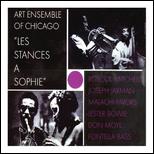Marketing
Art Ensemble of Chicago - Les Stances a Sophie (1970)

Art Ensemble of Chicago - Les Stances a Sophie (1970)
Jazz | MP3 | 192kbps | 46,4MB
With this release Soul Jazz Records are reissuing a long lost album by The Art Ensemble Of Chicago, one of the most important and radical Jazz groups to come out of the USA.
'Les Stances A Sophie' was recorded in Paris in 1970 and features the regular Art Ensemble members (Lester Bowie, Joseph Jarman, Roscoe Mitchell and Malachi Flavors) alongside the newly recruited drummer Don Moye and Fontella Bass on vocals and piano.
Fontella Bass (who was married to Lester Bowie) had a successful career as a soul singer ('Rescue Me' was her biggest hit in the sixties).
The addition of these two performers maybe in some way explains the uniqueness of this recording, especially 'Theme De Yoyo' . Vocals (and lyrics) alongside a constant drum and bass beat were new elements to the recorded music of the Art Ensemble at this time and this recording would appear to contradict the AEC's ambition for music to be heard and played simply as Sound with the freedom from accepted forms (ie Blues, Jazz etc) that were used to describe music.
Ornette Coleman, John Coltrane, Albert Ayler were the forerunners of Free Jazz (The New Jazz). Far from being simply a musical concept these musicians began to redefine the concept of the African-American musician in society. A new period of self-respect and spirituality among musicians was led by these musicians. Parallel to this, of course, was the Civil Rights Movement led by Martin Luther King and Malcolm X that was encouraging self-determination in every African-American.
The Association for the Advancement of Creative Musicians was formed in Chicago in 1965 by Muhal Richard Abrams with members including future AEC members Bowie, Jarman, Mitchell and Flavors as well others such as Anthony Braxton and Amina Claudine Myers. The AACM began promoting concerts, teaching music, Black history and offering spiritual guidance to youngsters in the community. This radicalisation of thought happened as the AACM musicians turned their back on the accepted path of a Jazz musician (as nightclub performer/entertainer) and began to look to a more African concept of the musician as part of a community both responsible to him or herself and fulfilling a spiritual role within that community.
Sun Ra had begun a similar concept with his Arkestra. Before moving to New York in 1960, Sun Ra had been based in Chicago in the second half of the 1950's. Many in the Arkestra lived together communally. The Arkestra existed to explore and play new musical horizons. No one in the commune was allowed to drink or take drugs and as Sun Ra explored Jazz, Science Fiction, Theatre and History in his music he also brought to the members of his Arkestra the importance of a sense of self-respect as a musician. The space left by Sun Ra when his Arkestra moved to New York was in many ways taken up by the AACM when it formed in 1965.
The Art Ensemble formed in 1968 out of the aforementioned members of the AACM. In June 1969 they headed for France where for the next two years they recorded an astonishing amount of music. Over fifteen albums were recorded for various labels such as BYG, Freedom, Nessa, Arista and EMI. They played at numerous festivals throughout Europe in this space of time before returning to America in 1972.
Les Stances A Sophie came about when the director of the film Moshe Misrahi befriended the Art Ensemble and asked them to record the soundtrack. During the filming the Art Ensemble were asked to appear in the film and for a few minutes in the film the group can be seen performing. (The photos on the cover are stills from this scene). The film remains, unfortunately, one of, if not the, most obscure French New Wave films ever to be made.
The fact that the music for the film was actually recorded before filming maybe accounts for one of the reasons that the music stands up on its own.
'Great Black Music - Ancient to Future' is how the Art Ensemble of Chicago came to describe their music. By managing to avoid the ideas of whether their music was Jazz or not the AEC were able to continue making music that could be as abstract as 'sound' or call upon the music of Africa or discuss Monteverdi at the same time as referring to the musical legacy of Duke Ellington or the Blues if they so chose. The Freedom that the AEC was employing was one that employed the right to enter into any area of music that they chose. It is in this way that 'Theme De Yoyo' makes sense.
Lester Bowie and Fontella Bass had met through Oliver Sain, who as a producer and bandleader, played with many Rhythm and Blues artists. Bowie and Bass were both playing with Sain before Fontella Bass started her solo career. 'Theme De YoYo' is where the Art Ensemble drew upon this Rhythm and Blues background to produce their interpretation of a Soul/R'n'B song with all the power of the AEC's collective musicianship on board. Bowie would occasionally return to this area of popular Black music during his career. For instance his version of The Flamingos Doo-Wop classic 'I Only Have Eyes For You' or his strange and humorous version of Michael Jackson's 'Thriller'.
'Les Stance A Sophie' was originally released on EMI France and later in the US on Nessa Records. Both editions have been out of print for many years and Soul Jazz Records are releasing it for the first time in England.
1. theme de yoyo
2. theme de celine
3. variations sur un theme de monteverdi
4. variation sur un theme de monteverdi (ii)
5. proverbes (i)
6. theme amour universal
7. theme libre
8. proverbes (ii)
Link
pass: phineas
Post je objavljen 11.11.2008. u 21:52 sati.